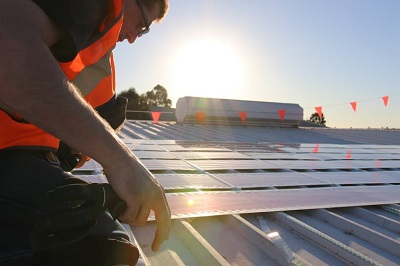 Friday, July 26, 2024
Friday, July 26, 2024  Friday, July 26, 2024
Friday, July 26, 2024 

Australia’s first commercial installation of printed solar cells, made using specialised semiconducting inks and printed using a conventional reel-to-reel printer, has been installed on a factory roof in Newcastle.
The 200 square metre array was installed in just one day by a team of five people. No other energy solution is as lightweight, as quick to manufacture, or as easy to install on this scale.
Our research team manufactured the solar modules using standard printing techniques; in fact, the machine that we use typically makes wine labels. Each solar cell consists of several individual layers printed on top of each other, which are then connected in series to form a bank of cells. These cells are then connected in parallel to form a solar module.
Since 1996, we have progressed from making tiny, millimetre-sized solar cells to the first commercial installation. In the latest installation each module is ten metres long and sandwiched between two layers of recyclable plastic.
At the core of the technology are the specialised semiconducting polymer-based inks that we have developed. This group of materials has fundamentally altered our ability to build electronic devices; replacing hard, rigid, glass-like materials such as silicon with flexible inks and paints that can be printed or coated over vast areas at extremely low cost.
As a result, these modules cost less than A$10 per square metre when manufactured at scale. This means it would take only 2-3 years to become cost-competitive with other technologies, even at efficiencies of only 2-3%.
Keep reading on TheConversation.com
Watch our video and learn more about the benefits of joining Construction Links Network – the peer-to-peer network sharing platform for the construction, building and design community.
Press Releases | Project Updates | New Appointments | Awards & Milestones | Company News | New Products/Services | Brochures | Videos | Infographics | Blog Sharing | Events and More